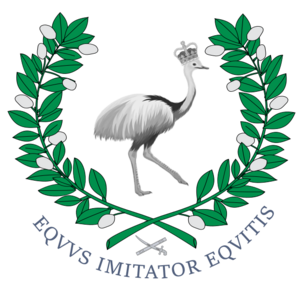User:Norcandy/Sandbox/Royal Satavian Light Horse
| 1st Batallion, Royal Satavian Light Horse | |
|---|---|
 Emblem of the Royal Satavian Light Horse | |
| Active | 4 October 1874 - 22 February 1941 |
| Disbanded | 22 February 1941 |
| Country | |
| Branch | Army |
| Type | Mounted infantry |
| Role | Light horse |
| Size | ~1,200 personnel |
| Part of | Western Military District (1874-1927) 1st Brigade (1927-1930) Satavian 1st Corps (1930-1937) Philipsbaai Division (1937-1939) 4th Cavalry Division (1939-1941) |
| Garrison/HQ | Zilverzee Barracks, Victoriaburg |
| Nickname(s) | "Crace's Band" "The Light Horse" |
| Motto(s) | Equus Imitator Equitis (Solarian: "The Horse Imitates the Rider") |
| Colours | Fern Green and Glaucous Grey |
| March | Quick - The Fires of Hephaestus Slow - The Great Rhea |
| Mascot(s) | Rhea |
| Equipment | Horse, rifle and bayonet |
| Engagements | Estmero-Verizi War |
| Commanders | |
| Notable commanders | Sir Thaddeus Crace Victor Hawksby |
| Insignia | |
| Unit colour patch |  |
The 1st Batallion, Royal Satavian Light Horse (1RSLH), commonly The Royal Satavian Light Horse (RSLH) was a mounted infantry batallion of the Satavian Army. Initially raised in the Western Freestate in 1874 as a colonial militia batallion, the Satavian Light Horse primarily dealt with supressing native unrest and policing large swathes of the Central Territory and Western Freestate. The batallion later saw active service abroad during the Estmero-Verizi War in the 1880s, after which the unit was awarded the distinction of the Royal title by Richard XII, and most notably during the Great War where the batallion served in Satavia before being evactuated to Euclea and later returned to Satavia during Operation Blind Summit. After the war, the batallion saw service in the occupied city of Philipsbaai and in Sainte-Chloé before it was disbanded in 1941. As a result of its long periods of foreign service, its battle honours include "Riziland" (Estmero-Verizi War), "Satavia", "Rolland", "Scitterland", "Swerdia" and "Hope" (Great War).
History
Early years & formation (1874-1882)
The Satavian Light Horse was established in 1874 as a colonial militia, and was tasked by the Governor of the Western Freestate, Patrick Brook-Bank, with the implementation of Johan Van Vallier's forced native resettling scheme within the province. During this period, the Satavian Light Horse were involved in multiple atrocities against local native populations. An inquiry launched in 1936 by the government of Edward Limes was unfinished at the time of his removal during the military coup of February 1939, and buried. The unfinished inquiry was the subject of controversy in 2019 after a freedom of information request by the Hope Post to release the findings of the inquiry was denied, on national security grounds. A legal challenge through the High Court of Satavia eventually saw the release of the inquiry's findings in 2021. Amongst the different atrocities revealed was the Karamangasdorp massacre, in which members of the Satavian Light Horse murdered all the inhabitants of the village of Karamangasdorp near Plaasgrondstad, resulting in the deaths of an estimated 150 people, a significant portion of which were women and children.
Estmero-Verizi War (1882-1884)
The eruption of the Estmero-Verizi War left Estmerish forces in Bahia severely depleted. With no significant forces avaliable in the nearby Estmerish colony of Kabu, the Satavian Light Horse was deployed to Rizland in order to help reinforce local Estmerish Forces. The first contingents of the Satavian Light Horse arrived in Port Fitzhubert in early July 1882. The unit was paired operationally with local volunteers, and until early 1883 only saw action in minor skirmishes against local Verizi forces. The Satavian Light Horse first saw major action during the Battle of Rutendo, in which the cavalry of the Light Horse, combined with the Estmerish use of Gatling guns, was instrumental in the decisive victory. Estmerish forces struggled with disease during the campaign, in paticular malaria - however, Satavian forces were less susceptiable to malaria due to the prevelance of malaria within Satavia and the consequent resistence developed from prolonged exposure. The Satavian Light Horse were present at the Battle of Crogan and the Battle of Bohero, but were largely ineffective at Bohero due to the thick jungle.
The Satavian Light Horse were most notably present during the Siege of Munzwa, where the Light Horse was initially tasked with preventing supplies from entering the city via the Rwizikuru River. After the commencement of the Battle of Munzwa on 21 January, 1884 the Light Horse fought within the city walls, largely dismounted. After the fall of the citadel on the night of the 24 January, the Light Horse were a significant party to the reprisals conducted on the local populace of Munzwa, and its subsequent buring. Members of the Light Horse were noted for their brutality towards the native populace by Estmerish officers, but were nonetheless allowed to continue unhindered. Shortly after the conclusion of open hostilities in June 1884, the Light Horse were recalled to Satavia where in 1885 Richard XII conferred the "royal" title on the regiment as recognition of their services during the Estmero-Verizi war.
